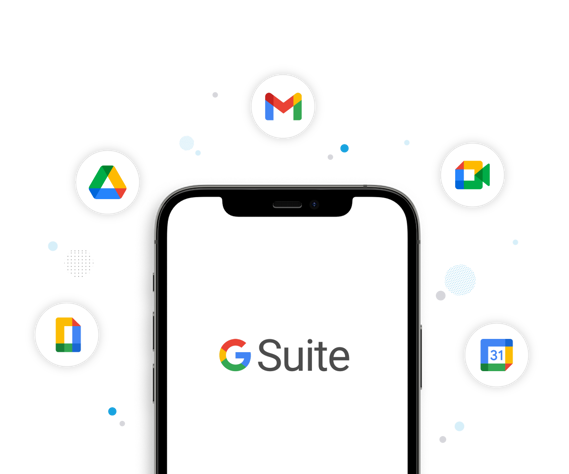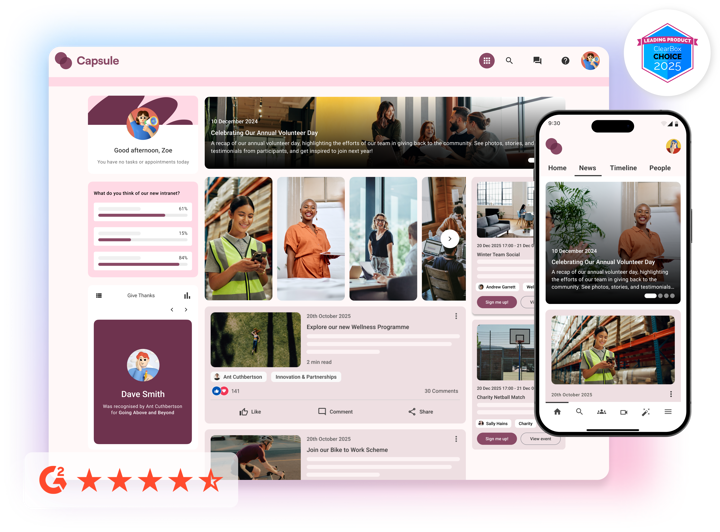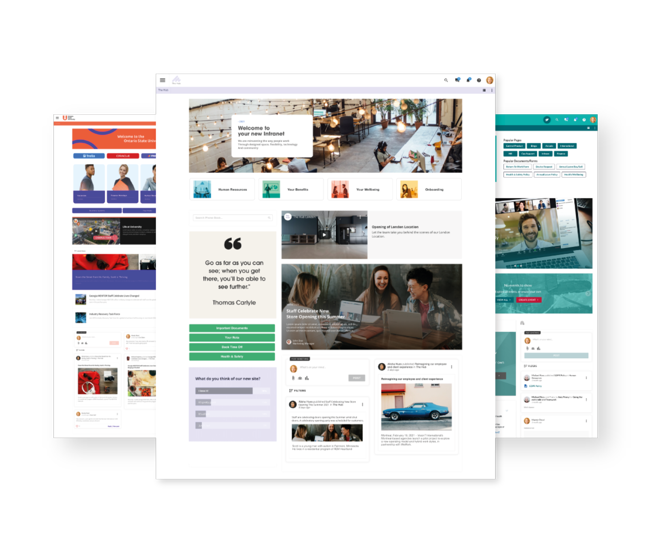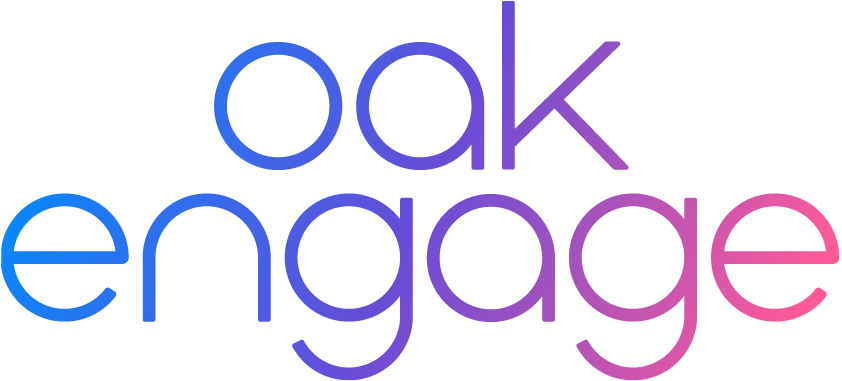Google Workspace is the foundation of collaboration for millions of teams. But as organisations grow, they quickly discover a gap: Workspace is exceptional for day-to-day productivity, yet it isn’t designed to manage communication, culture, knowledge or the needs of frontline employees.
This is where many organisations naturally evolve towards Google Workspace intranets—modern intranets that integrate with Workspace and create the missing layer of communication, clarity, governance and employee experience that today’s workforce expects.
A Google Workspace intranet doesn’t replace Workspace.
It completes it.
In this guide, we’ll walk through:
-
what a Google Workspace intranet is
-
why Workspace alone can’t support internal communication or organisational clarity
-
how an intranet strengthens knowledge access, culture and engagement
-
the benefits for hybrid, remote and frontline teams
-
how modern intranet platforms like Oak Engage bring everything together in one intuitive experience

What Are Google Workspace Intranets?
A Google Workspace intranet is a modern intranet platform that integrates directly with tools like Google Drive, Docs, Sheets, Slides, Calendar, Gmail, Chat and Google Identity. Bringing these together creates a single, connected digital workplace where employees can access everything they need—from policies to people updates—in one place.
Where Google Workspace focuses on productivity, a Workspace-integrated intranet strengthens:
-
internal communication
-
document governance
-
employee engagement
-
culture and community
-
centralised knowledge
-
people experience
-
personalised content
-
mobile access for frontline teams
Modern platforms like Oak Engage integrate seamlessly with Workspace, enabling organisations to:
-
embed Google Drive files directly into intranet content
-
surface Docs, Sheets and Slides in team hubs
-
use Google Identity for secure authentication
-
bring calendar events and updates into personalised feeds
-
centralise policies, news, onboarding and everyday resources
This is exactly what people mean when they search for Google Workspace intranets:
a smart, people-first layer that enhances everything Workspace does.

Why Google Workspace alone isn’t enough: 7 essential reasons to add an intranet
1. Google Workspace manages work. A modern intranet manages your organisation.
Workspace helps people get work done. But organisations run on more than tasks—they run on shared understanding, consistent communication and a strong sense of belonging.
A Workspace intranet provides the home for:
-
company-wide news
-
leadership messages
-
policies and procedures
-
onboarding journeys
-
cultural moments
-
recognition and celebrations
How platforms like Oak Engage support this
Modern intranets such as Oak Engage bring all of this into one personalised feed, making communication clearer, more relevant and easier for employees to absorb—something email alone can’t achieve.
2. Email and chat can’t support structured internal communication.
Gmail and Chat are brilliant for quick conversations. But they’re not built for:
-
reaching entire departments or frontline teams
-
sharing critical updates
-
providing mandatory reads
-
tracking who has seen what
-
offering a permanent home for important information
Messages get lost. Context disappears. People miss what matters.
What a Workspace-integrated intranet adds
-
centralised news
-
clear targeting (role, location, team)
-
mandatory read functionality
-
rich media communication
-
engagement and reach analytics
Oak Engage as an example
With platforms like Oak Engage, internal messages become more meaningful, more measurable and more inclusive, giving comms teams confidence that content lands with the people who need it most.
3. Knowledge is scattered across Drives and Docs and it slows teams down.
Over time, Google Drive becomes busy and complex:
-
duplicate files
-
outdated documents
-
inconsistent folder structures
-
siloed shared drives
-
unclear ownership
Employees waste time searching. New starters struggle to find what they need. Risks increase when outdated documents continue to circulate.
What a Workspace intranet contributes
-
well-organised knowledge hubs
-
policy libraries with clear version control
-
ownership and review cycles
-
cross-platform intranet + Drive search
-
structured onboarding journeys
Oak Engage as an example
Modern platforms like Oak Engage integrate with Google Drive to centralise and govern content—helping teams trust that what they find is accurate, approved and up to date.
It becomes your single source of truth.
4. Frontline and deskless workers get left out of Workspace.
Frontline teams often don’t have:
-
corporate email accounts
-
regular computer access
-
visibility of important Google updates
-
easy access to policies or processes
The result?
Gaps in communication, disconnected experiences and inconsistent information.
A modern intranet bridges the gap
-
mobile-first access
-
offline functionality
-
push notifications
-
localised updates
-
quick access to essential documents
How platforms like Oak Engage deliver this
Intranets such as Oak Engage give every employee, whether they’re at a desk, on a shop floor or out in the field—equal access to news, information and learning. This levels the playing field and strengthens culture across the organisation.
5. Google Workspace doesn’t provide a home for culture or community.
Work happens in Workspace.
Culture happens elsewhere—unless you intentionally create a space for it.
Workspace doesn’t offer:
-
social feeds
-
interest groups
-
recognition tools
-
wellbeing spaces
-
employee voice channels
-
community networks
-
shared storytelling
What a Workspace intranet adds
-
employee communities
-
social interactions
-
recognition and celebrations
-
wellbeing and support hubs
-
values-led storytelling
-
feedback and idea channels
Oak Engage as an example
People-first platforms like Oak Engage make it easy for employees to connect with one another, share experiences and feel part of something bigger, no matter where they work.
6. Tool sprawl becomes overwhelming—and Workspace can’t unify everything.
Even organisations that rely heavily on Google Workspace still use many additional tools:
-
HR and people systems
-
scheduling and rota tools
-
training platforms
-
payroll
-
ticketing and operations tools
Employees end up switching between systems, hunting for links and losing time.
An intranet becomes your unified gateway
-
personalised quick links
-
embedded tools
-
global search
-
integrated workflows
-
one home for everything
How Oak Engage supports this
Modern intranets like Oak Engage unify Google Workspace with wider business systems—giving employees a single, seamless entry point to their entire digital workplace.
7. Google Workspace lacks measurement for internal communication.
Workspace doesn’t show:
-
who has seen important updates
-
which groups are disengaged
-
what content resonates
-
how frontline teams engage
-
which channels work best
Without insight, internal communication becomes reactive.
A modern intranet provides real data
Analytics help teams understand:
-
content reach
-
engagement patterns
-
communication gaps
-
high-performing formats
-
team-by-team and site-by-site visibility
Oak Engage as an example
Intranets like Oak Engage give comms teams the insights they need to improve strategy, demonstrate impact and build a more connected workforce.
Google Workspace alone vs Google Workspace and an intranet
| Capability | Workspace Alone | Workspace + Modern Intranet |
|---|---|---|
| Productivity tools | ✔ Excellent | ✔ Unified + enhanced |
| Internal communication | ❌ Limited | ✔ Targeted + measurable |
| Knowledge management | ❌ Fragmented | ✔ Governed + structured |
| Frontline access | ❌ Weak | ✔ Mobile-first + inclusive |
| Culture & engagement | ❌ Not supported | ✔ Communities + recognition |
| Document findability | ❌ Inconsistent | ✔ Global search + hubs |
| Governance | ❌ Minimal | ✔ Workflows + version control |
| People experience | ❌ Basic | ✔ Personalised + connected |
This reflects exactly what people look for when exploring Google Workspace intranets.
Why Modern Intranets Like Oak Engage Are Ideal for Google Workspace Organisations
Modern intranets, such as Oak Engage are purpose-built to complement Workspace by offering:
-
seamless integration with Google Drive, Docs and Calendar
-
mobile-first access for frontline and remote teams
-
structured communication channels
-
governed knowledge hubs
-
vibrant social and community features
-
personalised, role-based content
-
actionable analytics and insights
They bring together everything employees need in one intuitive, human-centred experience—strengthening communication, culture and clarity across the organisation.

How to Implement a Google Workspace Intranet
Rolling out a Google Workspace intranet is one of the most effective ways to bring clarity, connection and consistency into your digital workplace. Whether you’re starting from scratch or upgrading an existing setup, the process becomes much smoother when you take a structured approach.
Here’s a simple, people-first way to get started.
1. Define your goals clearly
Before selecting features or planning content, understand why you’re introducing an intranet. Most organisations focus on goals such as:
-
improving communication across teams and locations
-
centralising knowledge and policies
-
supporting frontline and deskless workers
-
giving leadership a clear, consistent communication channel
-
creating one place for tools, updates and resources
-
strengthening culture and belonging
Having this clarity upfront ensures the intranet supports the exact outcomes you need.
2. Map your employee groups and how they work
Every organisation has different audiences:
-
office-based teams
-
hybrid teams
-
remote workers
-
frontline and deskless employees
-
contractors or temporary staff
Understanding where, when and how people work allows you to shape an intranet that feels inclusive and relevant for everyone.
This is also where features like targeting, mobile access and personalised feeds truly shine.
3. Connect your Google Workspace tools
A Workspace-integrated intranet becomes much more powerful when everything joins together. This includes:
-
embedding Google Docs, Sheets and Slides into content
-
surfacing Drive files inside knowledge hubs
-
using Google Identity for login and permissions
-
syncing with Google Calendar
-
pulling Workspace updates into personalised feeds
Platforms like Oak Engage make these connections seamless, so employees feel like they’re using one unified system rather than juggling multiple tools.
4. Build your communication and knowledge hubs
Once your structure is in place, it’s time to build the core areas employees rely on every day:
-
company news and updates
-
leadership communication
-
policies and procedures
-
onboarding and training content
-
departmental hubs
-
social and community spaces
Think of this as creating the digital “home” where people land each day.
A clean, intuitive structure makes information feel easy to find and easy to trust.
5. Launch with a strong, people-first communication plan
A great intranet doesn’t just go live — it’s introduced with purpose.
Your launch might include:
-
teaser messages
-
leadership support
-
demo videos or tours
-
spotlighting key features
-
highlighting quick wins for employees
-
encouraging teams to share stories or posts
This creates early momentum and helps employees get comfortable with the platform from day one.
6. Encourage continuous engagement
The most successful intranets evolve organically because teams:
-
post updates
-
share documents
-
celebrate moments
-
create communities
-
ask questions
-
respond to news
-
contribute ideas
Make space for employees to be active participants, not passive readers.
This builds belonging and strengthens culture over time.
7. Use analytics to refine and improve
Once your intranet is live, real insight comes from understanding how people use it.
Analytics can show:
-
which content reaches employees
-
what people search for
-
where information gaps exist
-
how frontline teams engage
-
the best-performing communication formats
Platforms like Oak Engage provide this visibility, helping you continuously improve communication and create an experience that truly works for your people.
Conclusion
Google Workspace enables teams to create, collaborate and deliver.
A modern intranet brings the people side together: communication, culture, knowledge and connection.
Together, they create a digital workplace where every employee—whether they're in an office, on the move or on the frontline, has what they need to do their best work and feel part of the organisation.
Integrating Workspace with a modern intranet, such as Oak Engage brings clarity, connection and consistency to the entire employee experience.
Workspace powers the work. The intranet completes the experience.
Change the way you work. Empower your people
We offer a free and personalised demo service, showcasing our intuitive and easy to use platform.



